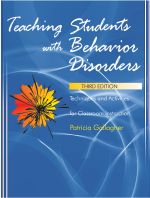 |
>TEACHING STUDENTS WITH BEHAVIOR DISORDERS
Techniques and Activities for Classroom Instruction – Third Edition |
|
Patricia A. Gallagher
The content in this book for teaching and managing elementary to eight grade students includes vignettes, curriculum topics and instruction, educational diagnoses, and positive management programs to help children with behavior disorders.
You will find 12 strategies for general and special education teachers to help students achieve academic and social success along with 10 psychological variables in the classroom environment that impact student behavior. Based on a perspective combining psychoeducation, behaviorism, and structure, the book contains classroom examples, forms, and illustrations. It is a warm and inviting book containing workable ideas to help troubled children succeed.
Contents
1. Troubled Youth: An Overview
2. Directions for Planning Academic and Behavior Success
3. Advanced Organization
4. Educational Diagnosis
5. Curriculum: Basic Considerations
6. Curriculum: Instructional Techniques
7. Curriculum: Essential Topics for Instruction
8. Responses to Students with Specific Needs
9. Management: Overview
10. Management: Affective Techniques
11. Management: Behavior Techniques
12. Management: Decision-Making Techniques
13. Communication with Significant Adults
14. The Job Interview
- Appendix A: Vignettes
- Appendix B: Promoting Dignity: Taking the Destructive Ds out of Behavior Disorders
400 pages
2008/paperback/ISBN 978-0-89108-324-5
$58.00
|
|
|
|
|
 |
>RESPONSE TO INTERVENTION FOR TEACHERS
Classroom Instructional Problem Solving |
| Mary E. Little
Response to Intervention (RtI) for Teachers: Classroom Instructional Problem Solving is an interactive, practical resource for teachers and other educators. RtI for Teachers reveals how to actively participate in the problem-solving instructional process. It provides a step-by-step approach to classroom instructional problem solving (action research), including descriptions of each phase, reflection activities, planning forms, and concrete, real-life examples. Through its practical, teacher-focused process approach based on current research, legislation, and policies, RtI for Teachers offers evidence-based resources in both instruction and assessments for use in classrooms and schools.
Special Features
- Linear, step-by-step instructions
- Case study
- Extensive planning, observation, and assessment forms
Contents
Introduction
Chapter 1: WHY? The Rationale for Classroom Instructional Problem Solving
Chapter 2: WHAT? An Overview of Classroom Instructional Problem Solving
Chapter 3: WHERE and WHEN? Classroom Questions in My Classroom Now
Chapter 4: HOW? The Four Phases of Classroom Instructional Problem Solving
Chapter 5: WHY? REVISITED: Rationale—Improved Student Learning
Through Classroom Instructional Problem Solving
Chapter 6: Case Study: Rosa
Appendixes
136 pages
2009/paperback/ISBN 978-0-89108-338-2
$29.95 |
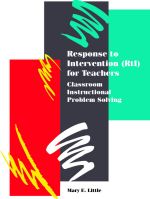 |
|
|
|
 |
>TECHNIQUES FOR MANAGING VERBALLY AND PHYSICALLY AGRESSIVE STUDENTS
Third Edition |
|
Beverley Johns
Valerie Carr
The latest edition of this classic book incorporates new strategies for handling violence and inappropriate behavior in our schools, including the implications of new technologies like cell phones, social networking, and cyberbullying. The authors provide how-to information and step-by-step methods for working with disciplinary problems and aggression within the school setting. It focuses specifically on techniques for breaking up fights, intervening in bullying, and working with students who talk back and refuse to do their work.
These classroom management techniques provide tangible results. Strategies for school-wide behavior management and community and parent involvement provide an integrated and comprehensive approach to addressing violence in our schools.
Contents
1. Facing the Challenge
2. The Classroom Climate
3. Ineffective Classroom Management Techniques
4. Successful Behavior Management
5. Behavioral Intervention Plans
6. Understanding Aggression
7. Dealing With Aggressive Behavior
8. Verbally Dealing With Aggression
9. Use of Time-Out
10. Bully-Proofing Your Classroom
11. Dealing With Physical Aggression
12. Breaking Up Fights
13. Police Intervention and Community Agency Involvement
14. Working Effectively With Parents
15. Administrative Issues
194 pages
paperback/ISBN 978-0-89108-342-9
$39.95 |
|
|
|
|
 |
| >COUNSELING KIDS WITH EMOTIONAL AND BEHAVIORAL PROBLEMS IN THE SCHOOLS
|
Mary N. Cook and Kathy Weldon
Counseling Kids With Emotional and Behavioral Problems in the Schools is a comprehensive text on counseling in a user-friendly format that makes it a joy for those who work with children with emotional and behavioral problems.
Cook and Weldon explore different emotional and behavioral problems and the children who exhibit them, including children who are depressed, unsafe, socially impaired, anxious, selectively mute, school-refusing, disruptive or ADHD, and difficult. The book also examines working with classes or groups, as well as crisis intervention from the counselor’s perspective.
Categorized by emotional or behavioral difficulty, each chapter dissects the epidemiology and major characteristics of the problem, assessment techniques, and interventions. The text relates countless scenarios, dialogues, and case studies and provides activities, games, and sample behavioral contracts to be used by counselors, teachers, and parents.
Special Features
- Provides essential information and statistics about each emotional or behavioral problem
- Emphasizes practical and usable strategies to effect change in children
- Includes three appendices with more than 40 blackline masters to be used around the office, classroom, or home
Contents
- The Depressed Child: What to Do With Kids Who Are Sad
- The Unsafe Child: What to Do With Kids Who Threaten to Harm Themselves or Others
- The Socially Impaired Child: What to Do With Kids Who Can’t Get Along With Others
- The Anxious Child: What to Do With Kids Who Worry Too Much
- The Selectively Mute Child: What to Do With Kids Who Won’t Talk at School
- The School-Refusing Child: What to Do When Kids Won’t Go to School
- The Disruptive or ADHD Child: What to Do When Kids Won’t Sit Still and Be Quiet
- The Difficult Child: What to Do When You’ve Tried Everything
- Working With Groups or Classes: How To Intervene With More Than One Child
- Crisis Intervention: How to Intervene in the Face of Tragedy
- Appendix A: Techniques for Counseling Socially Impaired Children
- Appendix B: Techniques for Counseling Anxious Children
- Appendix C: Techniques for Counseling Disruptive Children
- Appendix D: Sample Behavioral Contracts
0501/176 pages/2006
Paperback
ISBN 978-0-89108-313-9
$32.00 |
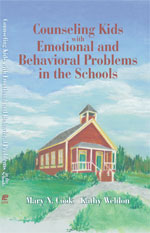 |
|
|
|
 |
| >TEACHING SOCIAL-EMOTIONAL SKILLS AT SCHOOL AND HOME |
| Linda K. Elksnin and Nick Elksnin
Teaching Social–Emotional Skills at School and Home is designed to provide teachers and parents with strategies for teaching children and youth to become socially and emotionally competent.
This book is research-based yet practical and easy to read. The authors examine all aspects of social–emotional learning, including emotional literacy, social problem solving, and the social skills essential for making friends and succeeding in school—making this text the most comprehensive available.
Readers will learn how to teach social–emotional skills at the individual, classroom, schoolwide, and districtwide levels by integrating instruction within the academic curriculum and how to make social–emotional learning part of school and family life.
Special Features
- Includes assessment approaches to identify children who need social–emotional skills instruction
- Contains practical activities to help children of all ages understand and regulate emotions, make and keep friends, solve social problems, and succeed in school
- Addresses the importance of social–emotional skills for gaining and maintaining employment
- Incorporates real-life vignettes that connect theory and practice
- Provides numerous useful forms, checklists, and planning sheets
Contents
- The Importance of Social–Emotional Competence
- Identifying Children and Youth Who Need Social–Emotional Skills Instruction
- Teaching Children and Youth to Understand and Regulate Emotions
- Teaching Children and Youth Social–Emotional Problem-Solving Strategies
- Teaching Children and Youth Peer-Pleasing Social–Emotional Skills
- Teaching Children and Youth Teacher-Pleasing Social–Emotional Skills
- Teaching Occupational Social–Emotional Skills
- Parents as Teachers
- Getting Children and Youth to Use Social–Emotional Skills
- Appendix A: Books for Parents, Children & Youth, and Teachers & Administrators
- Appendix B: Children’s Books Chosen by Children
0603/352 pages/2006
Paperback
ISBN 978-0-89108-316-0
$60.00 |
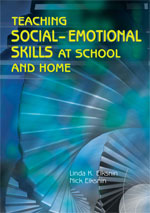 |
|
|
|
 |
>FUNCTIONAL BEHAVIORAL ASSESSMENT
A Systematic Process for Assessment and Intervention in General and Special Education Classrooms |
Mary E. McConnell, Turner School District,
Kansas City, Kansas
Functional assessment can be overwhelming to educators who are not familiar with the process. This book is designed specifically for persons who have limited training in applied behavior analysis and functional assessment procedures.
This easy-to-use manual will help educators understand the purpose and meaning of the functional behavior assessment process and how to identify and assess behavior. It shows how to develop and write effective Behavior Intervention Plans using data collected during the functional assessment.
Special Features
- Presents step-by-step procedures for conducting functional assessments
- Shows how to write Behavior Intervention Plans and select interventions
- Discusses data collection
- Includes dozens of checklists and plan sheets for working with Behavior Intervention Plans.
Contents
1. Introduction to IDEA and Functional Assessment
2. The Function of Functional Assessment
3. Functional Assessment Process
4. Behavioral Intervention Plans
5. Appendix Forms and Planning Sheets
114 pages
2001/paperback/ISBN 978-0-89108-277-4
$24.95 |
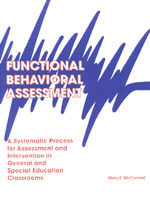 |
|
|
|
 |
| >TECHNIQUES FOR MANAGING A SAFE SCHOOL |
Beverley H. Johns, Four Rivers Special Education District, Jacksonville, Illinois
John P. Keenan, Assistant Chief of Police, Jacksonville, Illinois
This practical text covers techniques for combating truancy, collaborating with police, conflict resolution, and gang prevention and intervention measures.
The book is intended for all educators who ultimately will face behaviorally challenging students and compromising situations in schools. You’ll find ideas about dress codes, searches, sexual perpetrators in schools, and safety checklists.
Special Features
- Details the appropriate use of searches and interventions
- Solutions based on actual experiences of authors
- Designed to be used for all schools K–12
210 pages
1997/paperback/ISBN 0-89108-256-5
$29.95 |
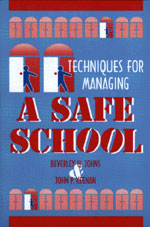 |
|
|
|
 |
>EMOTIONAL AND BEHAVIORAL DISORDERS
A 25-Year Focus |
| Richard J. Whelan, University of Kansas
The book begins with a discussion of current practices in the education and management of students with emotional and behavioral disorders. Subsequent sections define and classify behaviors, identify styles of coping, show procedures for identification, and present educational interventions.
You'll find chapters covering depression, dignity, interventions, instructional planning, and most importantly classroom practices.
Special Features
- A unique presentation that traces the transition and etiology of behavior disorders up to today
- Includes models for intervention, planning, classroom strategies, and research implications
- Highly practical and translates research into classroom practice
Contents
1. Current Perspectives on Emotional and Behavioral Disorders
2. Educational Practices
Part One: Affective Considerations
3. The Relationship Between Pupil Affect and Achievement
4. The Emotional Development of Exceptional Students
5. Depression in Children and Adolescents: Identification, Assessment, and Treatment
6. Promoting Dignity: Taking the Destructive D's out of Behavior Disorders
Part Two: Models of Intervention
7. Engineered Classroom
8. Teaching Children Self-Control
9. The Helping Teacher/Crisis Teacher Concept
10. Developing Self-Regulated Learners
11. Courage for the Discouraged: A Psychoeducational Approach to Troubled and Troubling Children
Part Three: Instructional Planning
12. Developing Instructional Materials for Children with Emotional and Behavioral Disorders
13. Integration of Exceptional Children into Regular Classes: Research and Procedure
14. Procedures for Developing Creativity in Emotionally Disturbed Children
15. Curriculum Modification as a Strategy for Helping Regular Classroom Behavior-Disordered Students
Part Four: Classroom Practices
16. Classroom Scheduling Techniques for Children with Emotional and Behavioral Disorders
17. Therapeutic Discussion Groups in Public School Classes for Children with Emotional and Behavioral Disorders
18. Application of the Self-Control Curriculum with Behavior-Disordered Students
19. Classroom Management: Teacher-Child-Peer Relationships
20. Management of Aggressive and Violent Behavior in the Schools
21. Perspective on the Future
416 pages
1998/paperback/ISBN 0-89108-254-9
$48.00
|
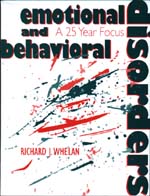 |
|
|
|

